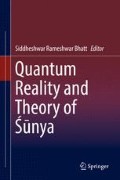Abstract
The very fact that a quantum measurement changes the quantum state of a system in an uncontrollable way implies that the measurement does not reveal the objective reality that existed before the measurement. We argue that the nature of certain special quantum states that emerge due to decoherent interaction with the environment is such that one can measure the expectation value of any observable of the system in a single measurement. This can be done even when such states are a priori unknown. The possibility of measuring the expectation value of any observable, without any prior knowledge of the state, points to the objective reality of such states.
Access this chapter
Tax calculation will be finalised at checkout
Purchases are for personal use only
References
Wheeler JA, Zurek WH, editors. Quantum theory and measurement. Princeton: Princeton University Press; 1983. p. 182–213.
Auletta G. Foundations and interpretation of quantum theory. Singapore: World Scientific; 2000.
Zeh HD, On the interpretation of measurement in quantum theory. Found Phys. 1970;1:69; Joos E, Zeh HD, The emergence of classical properties through interaction with the environment. Z Phys. 1985;D 59:223.
Giulini D, Joos E, Kiefer C, Kupsch J, Stamatescu I-O, Zeh HD, editors. Decoherence and the appearance of a classical world in quantum theory. Berlin/London: Springer; 1996.
Zurek WH. Decoherence and the transition from quantum to classical. Phys Today. 1991;44(10):36.
Gogolin C. Environment-induced super selection without pointer states. Phys Rev. 2010;A81:051127.
Breuer H-P, Petruccione F. The theory of open quantum systems. Oxford: Oxford University Press; 2002.
Zurek WH. Decoherence, einselection, and the quantum origins of the classical. Rev Mod Phys. 2003;75:715.
Zurek WH. Environment-induced superselection rules. Phys Rev. 1982;D26:1862.
Hornberger K. Introduction to decoherence theory. Lect Notes Phys. 2009;768:221.
Zurek WH. Environment-induced superselection rules. Phys Rev. 1982;D26:1862–80.
Zurek WH. Decoherence, einselection, and the quantum origins of the classical. Rev Mod Phys. 2003;75:715–75.
Zurek WH, Habib S, Paz JP. Coherent states via decoherence. Phys Rev Lett. 1993;70:1187.
Eisert J. Exact decoherence to pointer states in free open quantum systems is universal. Phys Rev Lett. 2004;92:210401.
Qureshi T. Decoherence, time scales and pointer states. Physica A. 2012;391:2286–90.
Paz JP, Zurek WH. Quantum limit of decoherence: environment induced superselection of energy eigenstates. Phys Rev Lett. 1999;82:5181.
Ollivier H, Poulin D, Zurek WH. Objective properties from subjective quantum states: environment as a witness. Phys Rev Lett. 2004;93:220401.
Aharonov Y, Vaidman L. Measurement of the Schrodinger wave of a single particle. Phys Lett. 1993;A178:38.
Aharonov Y, Anandan J, Vaidman L. Meaning of the wave function. Phys Rev. 1993;A47:4616.
Vaidman L. Protective measurements. In: Greenberger D, Hentschel K, Weinert F, editors. Compendium of quantum physics: concepts, experiments, history and philosophy. Berlin/Heidelberg: Springer; 2009.
Hari Dass ND, Qureshi T. Critique of protective measurements. Phys Rev. 1999;A59:2590–601.
Qureshi T, Hari Dass ND. Protective measurements: probing single quantum systems. Curr Sci. 2015;109:2023.
Schlosshauer M. State disturbance and pointer shift in protective quantum measurements. Phys Rev. 2014;A90:052106.
Gao S, editor. Protective measurement and quantum reality. Cambridge: Cambridge University Press; 2015.
Schlosshauer M. Decoherence, the measurement problem, and interpretations of quantum mechanics. Rev Mod Phys. 2004;76:1267.
Author information
Authors and Affiliations
Corresponding author
Editor information
Editors and Affiliations
Rights and permissions
Copyright information
© 2019 Springer Nature Singapore Pte Ltd.
About this chapter
Cite this chapter
Qureshi, T. (2019). Emergent Reality in Quantum from Classical Transition. In: Bhatt, S.R. (eds) Quantum Reality and Theory of Śūnya. Springer, Singapore. https://doi.org/10.1007/978-981-13-1957-0_3
Download citation
DOI: https://doi.org/10.1007/978-981-13-1957-0_3
Published:
Publisher Name: Springer, Singapore
Print ISBN: 978-981-13-1956-3
Online ISBN: 978-981-13-1957-0
eBook Packages: Religion and PhilosophyPhilosophy and Religion (R0)

